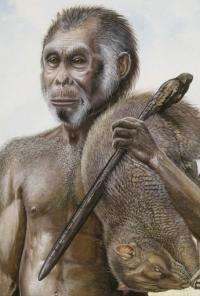'Hobbit' island colonised much earlier than thought

Flores, the Indonesian island where skeletal remains of famous "hobbit hominids" were found in 2003, was colonised by humans much earlier than thought, scientists said on Wednesday.
Humans settled in Flores around a million years ago, at least 120,000 years sooner than previously estimated, they reported in the journal Nature.
Flores leapt into the headlines seven years ago when archaeologists found the skeletal remains of tiny humans who measured only a metre (3.25 feet) in height, weighed just 30 kilos (65 pounds) and had the brain the size of a chimp's.
The extraordinary discovery sparked an intellectual battle that has raged ever since.
On one side are those who say the "hobbits" -- whose nickname is inspired by the little people of J.R.R. Tolkien's tales -- are a separate species of human, whom they honour with the Latin name Homo floresiensis, or Man of Flores.
On the other are those who dismiss the tribute, and argue the hobbits were just diseased Homo sapiens, with a disorder that made them midget-like.
The new study is based on the dating of a layer of volcanic sediment covering Stone Age tools found at a location called Wolo Sege, in the Soa basin of Flores.
"We don't know which hominins made the million-year-old tools because, regrettably, no human fossils were found with the tools," lead author Adam Brumm of the University of Woollongong, in Australia's New South Wales, told AFP in an email.
"However, our working hypothesis is that the Soa Basin toolmakers were the ancestors of ... Homo floresiensis, an argument that is supported in some ways by the close similarities between their stone tools."
The previous timing for the arrival of hominins, a term that covers humans and chimps, was 880,000 years ago, thanks to evidence at a site called Mata Menge, just 500 metres (yards) from Wolo Sege.
That date coincided with the mass death of two enigmatic species on Flores, a dwarf elephant called Stegodon sondaari and a giant tortoise named Geochelone.
The coincidence prompted some experts to pin the die-out on humans, whose expansion is notoriously linked to species extinction through hunting or habitat destruction.
But the new research suggests that, for once, man may not be to blame.
The cause of these animals' demise may well have been a volcanic eruption that blanketed the area, or other natural causes, including climate change, it says.
The hobbit remains, found farther west in the cave of Liang Bua in 2003, were about 18,000 years old, which means the hominids were contemporaries of Homo sapiens, as anatomically modern man is called.
If the hobbits are accepted as a separate species, it remains unclear how and when they emerged.
According to theories, they may have descended from branches of the human lineage known as Homo erectus or Homo habilis.
They would have derived their tiny size through "insular dwarfing", an evolutionary downsizing that occurs among creatures which move to islands where food is scarce.
(c) 2010 AFP
















